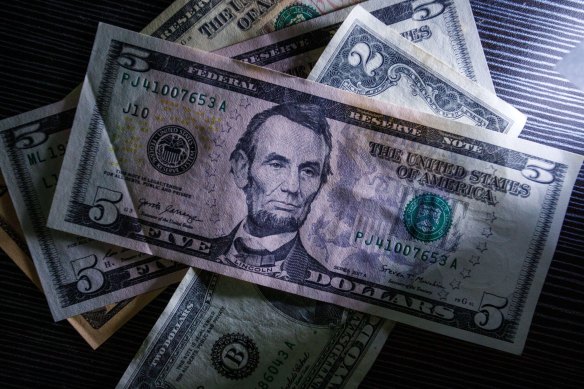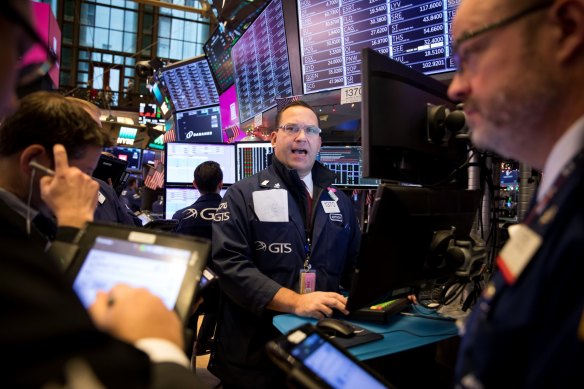This was published 1 year ago
Opinion
Why the US dollar is setting off alarm bells around the world
Stephen Bartholomeusz
Senior business columnistSuddenly, financial markets have become highly volatile, with the escalation of Middle East hostilities and last week’s increased US inflation reading generating tension and uncertainty.
The US dollar is surging and creating dilemmas for central bankers elsewhere.

The strength of the US dollar is causing problems across the globe.Credit: Bloomberg
Oil prices, already above $US90 a barrel, could go higher and add to the challenges faced by economic managers, depending on how Israel responds to the weekend barrage of drones and missiles.
Gold prices are at record levels despite the strength of the US dollar.
The US CPI numbers, which saw the inflation rate edging up, sent shockwaves through markets.
The stock market fell almost 1.5 per cent and US bond yields spiked significantly – both 2-year and 10-year yields ended the week 16 basis points higher.
The US dollar jumped nearly 2 per cent against the basket of its major trading partners’ currencies.
The Australian dollar was down more than US1.5¢, dropping from US66.29¢ to US64.75¢ after the CPI’s release was interpreted as ruling out any near-term cut to US interest rates.
Where, at the start of the year, markets had factored in as many as six rate reductions by the Federal Reserve Board this year, now the most optimistic case is that there might be two. Some economists are ruling out any increase while Larry Summers, the former US Treasury secretary, says there might even be a rate rise.
It appears the impact of the Biden administration’s very loose fiscal policies in negating the effects of the Fed’s tight monetary policies and keeping US inflation rates at levels the Fed is uncomfortable with might have been underestimated.

The inflation figures rattled Wall Street. Credit: Michael Nagle
The “high for longer” scenario that has now taken hold, and the US bond market’s response to the inflation data, means that the interest rate differentials between the US and other major – and minor – economies are widening.
Japan’s yen is now at a 34-year low against the dollar, the euro (which was already falling against the dollar) has depreciated further, by a fraction less than 2 per cent, since last Wednesday’s inflation data release.
China’s yuan has been edging down against the dollar all year, even though it is a “managed” currency. Emerging market currencies are under similar pressures – Indonesia had already been buying rupiahs and selling dollars to try to put a floor under its currency.
For central banks and economic policymakers whose economies are experiencing low growth and declining inflation, the dwindling prospect of lower US interest rates is a threatening complication.
The European Central Bank, for instance, has conditioned its markets to expect several rate cuts this year.
With the interest rate differentials already wide – the yields on two- and 10-year German bonds are already more than 2 percentage points lower than those on their US counterparts – further divergence could spark capital flight from Europe as investors pursue the higher returns available in the US.
The Japanese, amid widespread speculation that the Bank of Japan (BoJ) will intervene to put a floor under the yen, face a similar dilemma.
In an economy that has experienced decades of deflation, the emergence of modest inflation (it was running at 2.8 per cent in February) was welcomed.
Now, however, the BoJ is being confronted with an extremely volatile and weakening currency, which generates economic instabilities and capital outflows.
It may, as the European and Chinese authorities might have to choose between defending the currency with higher interest rates and/or market interventions that will dampen economic growth or risking large-scale and potentially destabilising capital outflows.
For some trade-exposed economies, like Australia’s, with declining but still too-high levels of inflation, depreciation risks rekindling the inflation rate because the cost of imported goods rises.
Currencies that are particularly liquid, like the yen and the Australian dollar, are particularly vulnerable because they are also used in so-called carry trades, where traders borrow in the market with lower interest rates and a weaker currency (or short that currency) while using the proceeds (or taking out long positions) in the higher-yielding US bond market.
If the US CPI data jolted the market, then the continuing instability in the Middle East – and Russia’s gains in Ukraine – have been an underlying influence on the dollar’s strength over the past month.
Reports of the dollar’s decline, built on attempts by China and Russia and some “Global South” economies to engineer it, may have been premature.
The Houthi attacks on shipping in the Red Sea and then the April 1 Israel strike on Iran’s consulate in Damascus had caused a flood of funds into the perceived safe havens of the US bond market and into gold.
Gold, which generates no income, is normally inversely correlated with the US dollar, but the safe haven effect has seen both rise in tandem.
Gold has also benefited from the impact of the US sanctions on Russia and the freezing of Russia’s offshore reserves, with other central banks, particularly in emerging economies, lowering their own risk of being sanctioned by buying gold rather than holding US dollar assets.
Now, after Iran’s attacks on Israel at the weekend, the appeal of safe haven assets is likely to be even stronger as investors wait to see whether Israel will retaliate and whether that presages a wider escalation of the conflicts in the Middle East.

The gold price has also soared as investors flock to the safe haven. Credit: Jim Rice
The dollar could rise further, adding to the conundrums faced by central bankers and other policymakers outside the US, US bond yields and the US sharemarket might weaken and gold and oil prices (Iran is a major oil producer) could rise even higher.
Higher oil prices would add to the momentum behind the dollar, given America’s relatively recently acquired status as the world’s largest oil producer and as a net exporter of oil.
Joe Biden has urged Israel to show restraint and has said the US won’t participate in any counter-attack on Iran by the American ally.
He doesn’t want a widening war in the Middle East that would draw a reluctant US into yet another messy overseas conflict. He also doesn’t, in an election year, want higher oil and gasoline prices.
If tensions in the Middle East were to subside, then so would oil prices, gold prices and, perhaps, the US dollar.
What the surge in the dollar, and the corresponding depreciations of other currencies over the past week underscores is the continuing global dominance of the dollar and US financial markets, particularly during periods of global volatility and heightened risk.
Reports of the dollar’s decline, built on attempts by China and Russia and some “Global South” economies to engineer it, may have been premature. Until there is an alternate safe haven for the world’s financial assets, that’s likely to remain the case.
The Market Recap newsletter is a wrap of the day’s trading. Get it each weekday afternoon.